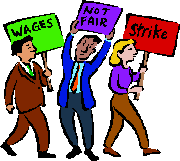By Melissa O'Rourke
For young workers who may not know what the advantages of being in a union are, the question "What's a union gonna do for me?" was answered in a report released last week by the Center for Economic and Policy Research.
The report detailed good news and bad news. The bad news is that workers aged 18-29 have the lowest unionization rates of any age group, and they have been hit hardest by the stagnant wage growth over the last three decades. This is despite a substantial increase in the number of young workers with college degrees.
The good news is that young workers who are in a union make an average of 12.4%, or about $1.75 an hour, more than non-union workers. They are also 17% more likely to have employer-provided health insurance and 24% more likely to have a pension plan.
According to American Rights at Work, the Employee Free Choice Act would give workers a fair and direct path to form unions through majority sign-up, help employees secure a contract with their employer in a reasonable period of time, and toughen penalties against employers who violate their workers' rights. Senator Barack Obama not only supports the legislation, but is a co-sponsor. Senator McCain opposes it completely.
For young workers in the lowest-wage occupations, the study shows the contrast between union and non-union is even more stark. The median young worker in a low-wage occupation earned $10.62, almost two dollars an hour more than the $8.74 the median non-union young worker earned. These benefits also carried over into their health care coverage, 40% of union workers vs. less than 20% of non-union workers, and 29% had a pension compared to only 11.2% of their non-union counterparts.
In these tough economic times, the union advantage is not only strong, but obvious and necessary. If young workers are to survive, thrive and build a solid future, we must make sure the Employee Free Choice Act is enacted.
The report can be read in its entirety here.


1 comment:
Young people tend to have a radical edge anyway so getting them to buy into the notion that through a union they can have more control over their lives, wages and workplaces is not as hard as it is with older workers.
Unions however are not seeking out the young at their work places agressively enough - I am reminded of an organizing campaign that the Teamsters participated in at a McDonalds in Ohio in the 90's. The workers all of them young people had had enough with managements poor treatment and one day simply walked off the job as a unit - amazing, their instict told them that they didn't have to bear the treatment any more so they took action...
A teamster organizer or business agent stumbled onto the scene and offered the locals help. Ultimately the drive wasn't successful and didn't last long but it wasn't due to lack of interest on the part of the young workers, it was the union that withdrew it's support and left the workers high and dry.
On the other hand, some of us might be familiar with the IWW's Starbucks Union that has been organizing the young Barista's in NYC, Chicago and the Mall of American - there is a drive that has consistency and the ability to spread (which it has) to other stores across state lines - the difference is that IWW is worker run whereas the teamsters are a "business" union like most and where one is the young workers organizing themselves the other is an outside force looking to add dues paying members.
We need to be agressive about organizing the young ~ union organizing is that training ground for direct action and political activity
Post a Comment